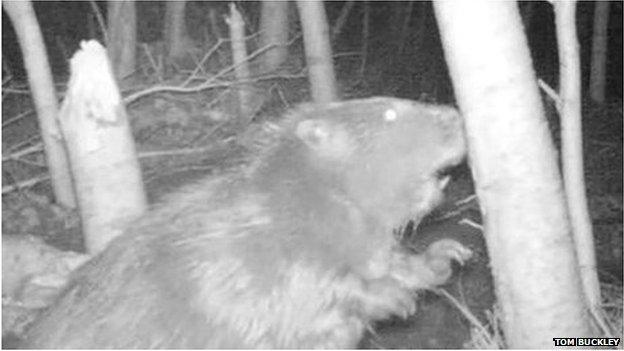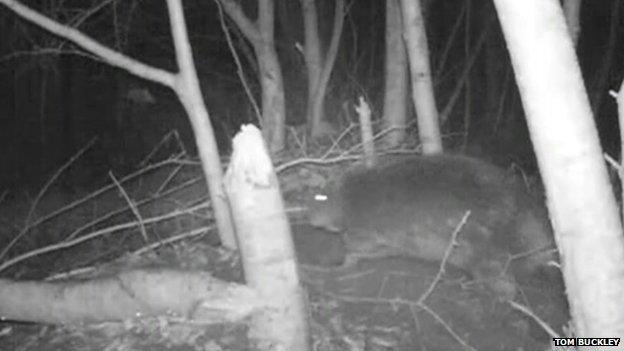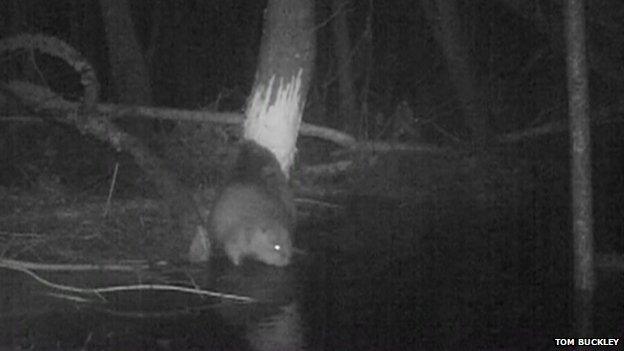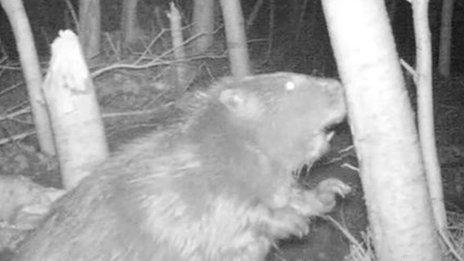Legal fight begins to save family of beavers in Devon
- Published

Beavers filmed on the River Otter in Devon bring "a little more joy into our landscape", say campaigners
Campaigners have begun legal action to prevent the government from capturing a family of wild beavers in Devon.
Friends of the Earth said because groups already live in the wild in Scotland, the beavers are protected in England under EU laws.
The River Otter beavers are believed to be the only wild ones living in England.
The government said they could be carrying disease and wants to test and re-home them in captivity.
The three beavers, thought to be two adults and a juvenile, were first reported to be living on the river in the summer of 2013 and no date has been set for trapping them.

The beavers were first reported to be living on the river in the summer of 2013

Defra wants to rehome the beavers "in a suitable location"
The Department for Environment, Food and Rural Affairs (Defra) said the beavers could be carrying a disease "not currently present in the UK".
Friends of the Earth has filed papers at the High Court in London requesting a judicial review into whether Natural England followed the correct procedures in issuing licences for capturing the beavers.
Spokesman Alasdair Cameron said: "You cannot just capture a population without considering its conservation status.
"They are entitled to protection as a legally protected species under European law.
"We know that beavers can bring many benefits, such as boosting fish stocks, improving biodiversity and helping to prevent flooding - as well as injecting a little more joy into our landscape."
A Defra spokesperson said: "Beavers have not been an established part of our wildlife for the last 500 years and their presence could have a negative impact on the surrounding environment and wildlife.
"These animals may also carry a disease which could pose a risk to human health.
"Once captured and tested, we intend to rehome them in a suitable location, and all decisions will be made with the welfare of the beavers in mind."
-
Beaver
×Beaver: Hunted to extinction for fur, meat and medicine, they were officially reintroduced to Knapdale Forest in Argyll, south-western Scotland, between 2009-10. The trial is the first formal reintroduction of a mammal to take place in the UK. Colonies that have recently appeared on the River Tay in eastern Scotland, and the River Otter in Devon, are of more mysterious provenance. In June 2015 it was reported that one of the females living on the River Otter had given birth.
-
Goshawk
×Goshawk: Wiped out in the 19th Century, partly due to deforestation and relentless persecution by gamekeepers. Unofficially re-introduced from the 1960s onwards by falconers and hawk-keepers, some were deliberately released and others escaped into the wild. There are thought to be about 500 pairs in Britain - 150 of them in Scotland, mainly in the borders, the north-east and Dumfries and Galloway.
-
White-tailed sea eagle
×White-tailed sea eagle: Became extinct in the early 20th Century, reintroduced to the Isle of Rum, one of the islands of the Inner Hebrides, in 1975. The white-tailed eagle is the largest UK bird of prey, with a wingspan of about 2.45m (eight feet). Numbers are still very low as work to reintroduce the species has been hampered by the theft of eggs.
-
Osprey
×Osprey: Having disappeared from the British Isles by the start of the 20th Century, they began breeding again at Loch Garten in Strathspey in 1954. Since then conservationists have worked hard to encourage the population to increase by protecting nests and introducing the bird to other sites in Britain. There are now estimated to be between 200 and 250 breeding pairs.
-
Reindeer
×Reindeer: The most recent fossil evidence is 8,300 years old. Reintroduced into the Cairngorms in 1952, there is a single herd of about 150 animals. They range freely in the highlands, but are tame and popular with tourists.
-
Great bustard
×Great bustard: Hunted to extinction in 1832, they were reintroduced to Salisbury plain in 2004, with the first chick fledging in 2009. The great bustard is one of the heaviest flying birds alive today - the male bird can reach up to one metre tall (3ft3in) and weigh 16kg (35lb).
-
Red kite
×Red kite: Reduced to a handful of birds in Wales, the red kites were released in north Scotland and the Chiltern Hills in Buckinghamshire in SE England during the late 80s and early 90s. Successful breeding populations have become established in both locations and since then more birds have been released in other locations. There are now thought to be more than 1,000 breeding pairs in the Chilterns alone.
-
Large blue butterfly
×Large blue butterfly: First recorded in 1795, the large blue was extinct by 1979 due to loss of suitable habitat. Following a reintroduction with Swedish stock, there are now estimated to be more than 10,000, spread over 11 sites, mainly in south-west England, including the Polden Hills in Somerset, Dartmoor and Gloucestershire.
-
Pool frog
×Pool frog: Became extinct in England in the 1990s. About 70 from Sweden were reintroduced in Norfolk in 2005. The pool frog has since beeen reintroduced at a number of other sites, including Hampshire, Surrey and Essex. Latest evidence suggests they are now well-established and breeding.
-
Lynx
×Lynx: Applications have been submitted for a five-year trial to release around 18 lynx at sites in Norfolk, Cumbria, Northumberland and Aberdeenshire. Reintroductions into other European countries have been remarkably successful. The lynx hunts deer and smaller prey such as rabbits and hare, and is not regarded as a danger to humans.
- ×
- Published25 September 2014

- Published11 July 2014

- Published1 July 2014

- Published27 February 2014
